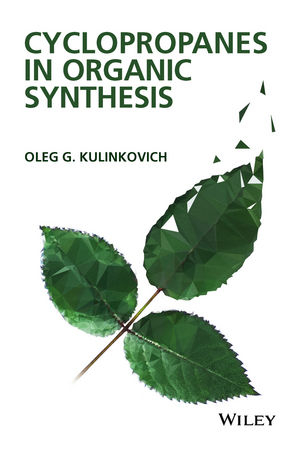
Cyclopropanes in Organic Synthesis
John Wiley & Sons Inc (Verlag)
978-1-118-05743-8 (ISBN)
• Provides comprehensive lists and synthetically-oriented synopses of cyclopropane chemistry review references along with publication data on applications in the syntheses of natural and related biologically active compounds
• Acts as a resource to help readers better understand cyclopropane applications for the efficient realization of synthetically important organic transformations and popular experimental procedures
• Includes new developments and up-to-date information that will lead to original methodologies for complex organic synthesis
• Stresses universality, flexibility, and experimental efficiency of a strategy based on preparing cyclopropane derivatives and performing ring cleavage reactions with inexpensive reagents
• Focuses on the synthetic potential of cyclopropane applications, for example the synthesis of natural compounds and other target-oriented syntheses via cyclopropane intermediaries, as well on their planning by retrosynthetic analysis
Oleg Kulinkovich was the head of the Department of Organic Chemistry from 1993-2003 and the head of the Laboratory of Organoelement Synthesis at Belarusian State University and visiting professor at Tallinn University of Technology. His seminal work on titanium-catalyzed cyclopropanation of carboxylic esters with Grignard reagents bearing β-hydrogen atoms (Kulinkovich reaction) is very well-known. Dr. Kulinkovich has published several reviews and original articles on organic synthesis in leading international journals.
Preface ix
Part I Reactivity and availability 1
Introduction, 1
Reference, 2
1 Structure and Reactivity of the Cyclopropane Species 3
1.1 Geometry and Bonding, 3
1.2 Energy, 4
1.3 Spectra, 5
1.4 Cyclopropyl Cations, 5
1.5 Cyclopropyl Anions, 6
1.6 Cyclopropyl Radicals, 7
1.7 Cyclopropylidenes, 7
1.8 Cyclopropylcarbinyl Cations, 8
1.9 Cyclopropylcarbinyl Anions, 8
1.10 Cyclopropylcarbinyl Radicals, 10
1.11 Cyclopropylcarbenes, 10
1.12 Conclusion, 11
References, 13
2 Ring Cleavage Reactions 15
2.1 Cyclopropyl Activation, 16
2.1.1 Halogen, Oxy, and Sulfur Substituted Cyclopropanes, 16
2.1.2 Alkylidenecyclopropanes, 19
2.2 Cyclopropylcarbinyl Activation, 23
2.2.1 Halogeno, Oxy, Acyl and Metallomethyl Cyclopropanes, 23
2.2.2 Alkylidenecyclopropanes, 27
2.2.3 Vinyl and Ethynyl Cyclopropanes, 29
2.2.4 1,2]Divinylcyclopropanes, 33
2.2.5 Acceptor Cyclopropanes, 35
2.2.6 Donor Cyclopropanes, 38
2.2.7 Donor–Acceptor Cyclopropanes, 43
2.3 Conclusion, 48
References, 49
3 Synthesis of Cyclopropanes 57
3.1 1,3]Cyclization Reactions, 57
3.1.1 Cyclizations with Cleavage of Two Single Bonds, 58
3.1.2 Cyclizations with Cleavage of One Double Bond and One Single Bond, 59
3.1.3 Cyclizations with Cleavage of Two Double Bonds, 62
3.2 [2 + 1] Cyclization Reactions, 65
3.2.1 Cycloaddition of Carbene Equivalents to Olefins, 66
3.2.2 Coupling of 1,1]Carbodianion and 1,2]Carbodication Equivalents, 79
3.2.3 Coupling of 1,1]Carbodication and 1,2]Carbodianion Equivalents, 83
3.3 Addition Reactions to the Double Bond of Cyclopropenes, 88
3.4 Interconversion of Cyclopropanes, 90
3.5 Conclusion, 90
References, 90
Part Ii Synthetic Application 99
Introduction, 99
References, 100
4 Triangulation Retrosynthetic Analysis 103
4.1 Retrosynthetic Triangulation, 103
4.2 Conclusion, 108
References, 108
5 Acyclic Compounds 109
5.1 Formation of Carbon Substituents, 109
5.1.1 Nonactivated Cyclopropane Precursors, 109
5.1.2 Cyclopropylcarbinyl Activated Precursors, 112
5.1.3 Cooperatively Activated Precursors, 138
5.2 Formation of Olefin Groups, 139
5.2.1 Cyclopropylcarbinyl Activated Precursors, 139
5.2.2 Cyclopropyl Activated Precursors, 142
5.2.3 Fragmentation of the Cyclopropane Precursors, 146
5.2.4 Cooperatively Activated Cyclopropane Precursors, 147
5.3 Formation of Carbonyl Groups, 151
5.3.1 Cyclopropylcarbinyl Precursors, 151
5.3.2 Cooperatively Activated Precursors, 156
5.4 Retrosynthetic Account, 162
References, 163
6 Cyclobutane Derivatives 167
6.1 Grandisol Syntheses, 167
6.2 Cyclobutane Synthetic Intermediates, 169
6.3 Retrosynthetic Account, 183
References, 184
7 Cyclopentanes 187
7.1 Vinylcyclopropane–Cyclopentene Rearrangement, 187
7.1.1 Cyclopropylcarbinyl Activated Precursors, 187
7.1.2 Cooperatively Activated Precursors, 188
7.2 Cycloaddition Reactions, 221
7.2.1 Cyclopropylcarbinyl Activated Precursors, 221
7.2.2 Cooperatively Activated Precursors, 221
7.3 Modification of Substituents, 223
7.3.1 N onactivated Cyclopropane Precursors, 223
7.3.2 Cyclopropylcarbinyl Activated Precursors, 224
7.3.3 Cooperatively Activated Precursors, 231
7.3.4 Fragmentation Reactions, 245
7.4 Retrosynthetic Account, 246
References, 246
8 Cyclohexanes 251
8.1 Intramolecular Cyclization Reactions, 251
8.2 Cycloaddition Reactions, 255
8.3 Modification of Substituents, 269
8.3.1 Cyclopropylcarbinyl Activated Precursors, 269
8.3.2 Cyclopropyl Activated Precursors, 275
8.3.3 Cooperatively Activated Precursors, 277
8.4 Retrosynthetic Account, 282
References, 283
9 Cycloheptanes 285
9.1 Divinylcyclopropane–Cycloheptadiene Rearrangement, 285
9.2 Cycloaddition Reactions, 315
9.3 Modification of Substituents, 318
9.3.1 Nonactivated Cyclopropane Precursors, 318
9.3.2 Cyclopropylcarbinyl Activated Precursors, 318
9.3.3 Cyclopropyl Activated Precursors, 323
9.3.4 Cooperatively Activated Precursors, 325
9.4 Retrosynthetic Account, 329
References, 330
10 Cyclooctanes and Larger Carbocycles 333
10.1 Cycloaddition Reactions, 333
10.2 Modification of Substituents, 334
10.2.1 Cyclopropylcarbinyl Activated Precursors, 334
10.2.2 Cyclopropyl Activated Precursors, 338
10.3 Retrosynthetic Account, 340
References, 340
11 Heterocyclic Compounds 341
11.1 Intramolecular Cyclization Reactions, 341
11.1.1 Nonactivated Cyclopropane Precursors, 341
11.1.2 Cyclopropylcarbinyl Activated Precursors, 342
11.1.3 Cyclopropyl Activated Precursors, 378
11.1.4 Cooperatively Activated Precursors, 380
11.2 Cycloaddition Reactions, 387
11.2.1 Cyclopropylcarbinyl Activated Precursors, 387
11.2.2 Cooperatively Activated Precursors, 390
11.3 Modification of Substituents, 400
11.3.1 Cyclopropylcarbinyl Activated Substrates, 400
11.3.2 Cyclopropyl Activated Substrates, 402
11.3.3 Cooperatively Activated Substrates, 402
11.4 Retrosynthetic Account, 409
References, 410
CONCLUSION 415
AUTHOR Index 417
| Erscheint lt. Verlag | 18.12.2015 |
|---|---|
| Verlagsort | New York |
| Sprache | englisch |
| Maße | 152 x 236 mm |
| Gewicht | 839 g |
| Themenwelt | Naturwissenschaften ► Chemie ► Organische Chemie |
| Naturwissenschaften ► Chemie ► Physikalische Chemie | |
| ISBN-10 | 1-118-05743-0 / 1118057430 |
| ISBN-13 | 978-1-118-05743-8 / 9781118057438 |
| Zustand | Neuware |
| Haben Sie eine Frage zum Produkt? |
aus dem Bereich


